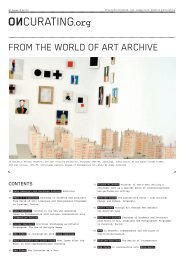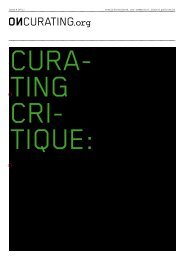You also want an ePaper? Increase the reach of your titles
YUMPU automatically turns print PDFs into web optimized ePapers that Google loves.
069 Issue # 11/11 : PublIc Issues<br />
I think of re-presentation <strong>as</strong> taking an existing thing<br />
and presenting it again in its re-formed version (rather<br />
than deforming it); this re-formed version takes shape<br />
according to changing spaces and situations. The radio<br />
example follows the same procedure. Oda changes methodologies,<br />
and thereby reflects upon a multiplicity of<br />
possibilities.<br />
Seçil: The quest and intention for cancelling out representation<br />
and for enacting its finalisation are significant.<br />
Otherwise we might e<strong>as</strong>ily be caught up within the<br />
vortex of contemporary discourses while trying to repeat<br />
the present we are inhabiting and to elaborate a critique<br />
or re-reading from the inside. This is ple<strong>as</strong>urable but at<br />
the same time dangerous! There is a need to escape from<br />
presentation, I believe. And the concept of re-presentation<br />
does not sound very different to me. Oda Projesi h<strong>as</strong><br />
been reflecting upon models of relationships all along.<br />
Is production devoid of any (re-)presentation possible?<br />
It's actually a somewhat self-destructive attitude; could<br />
we start from scratch by nullifying ourselves?<br />
Özge: This depends on what you mean by without presentation.<br />
I'm using the word in its b<strong>as</strong>ic meaning. If Oda Projesi<br />
is about making things visible, then it would mean that it<br />
presents something. For me the real issue is how to<br />
position ourselves against the spectacle that unfolds under<br />
the influence of marketing. Where does our spectacle reside<br />
in relation to this spectacle. or does it not reside any-<br />
where at all in relation to the spectacle? But representation<br />
is not something bad; <strong>as</strong> long <strong>as</strong> we look at our<br />
surroundings, <strong>as</strong> long <strong>as</strong> we are interested in the city, we<br />
are going to be bombarded by representations. Perhaps we<br />
can escape from the stableness or the single-signification<br />
of representation by regarding representations simply <strong>as</strong><br />
signs. Or can there be a counterstance in relation to what<br />
Roland Barthes describes: "Now, for a very long time –<br />
probably for the entire cl<strong>as</strong>sical capitalist period, i.e.<br />
from the sixteenth to the nineteenth century, in France –<br />
the uncontested owners of the language, and they alone,<br />
were authors; if we except preachers and jurists (enclosed<br />
moreover in functional languages), no one else spoke, and<br />
this 'monopoly' of the language produced, paradoxically, a<br />
rigid order, an orderless of producers than of production:<br />
it w<strong>as</strong> not the literary profession which w<strong>as</strong> structured<br />
(it h<strong>as</strong> developed greatly in three hundred years, from<br />
the domestic poet to businessman-writer)" (Barthes 1982,<br />
p. 185).<br />
The Misuse Value of Space<br />
Derya: If we go back to the concept of the misuse value<br />
of space that I have proposed, can we say that Oda Projesi<br />
misuses space? Oda Projesi bends and transforms space<br />
by trying to find usages that are beyond the prescribed<br />
meanings of space; it makes visible and realises the poten-<br />
tials of spaces by misusing them – on the condition that<br />
we understand misuse not in a negative sense. The question<br />
of spatial authorship enters the discussion here. Consequently,<br />
the status of specialists who are <strong>as</strong>sumed to<br />
possess the authority on the production of space is opened<br />
up for interrogation. What I'm actually trying to do is<br />
to talk about space by looking at the field of art. What<br />
are the convergences between art and authorship, between<br />
space and authorship, in the context of Oda Projesi?<br />
Özge: Perhaps we can go back to the beginning of Oda<br />
Projesi's activities. Perhaps we should first look at the<br />
ways in which designed space fails to operate <strong>as</strong> a con-<br />
sequence of the dynamics of everyday life and is forced to<br />
change. Perhaps we should<br />
also take the temporal dimen-<br />
sion into consideration <strong>as</strong><br />
we speak about process; and<br />
here we might look at the<br />
concept of pause, <strong>as</strong> elabora-<br />
ted by the curators of the<br />
Gwangju Biennial, who wanted<br />
to relate it to the ways in<br />
which relational projects<br />
tend to arrest time. 14 It is<br />
about regarding the present<br />
instead of glorifying the p<strong>as</strong>t<br />
(official history) or the<br />
future (ideals). It is about<br />
stopping and reflecting for<br />
a while (this is also a<br />
mental process) in the midst<br />
of experienced time and space<br />
in order to produce a punc-<br />
ture. And doing it with other<br />
people and formations of<br />
course, since the other route<br />
is being experienced natural-<br />
ly among ourselves. Actually<br />
at this point we can talk<br />
about Oda Projesi's function<br />
<strong>as</strong> the preservation of<br />
memory: paradoxically, we are<br />
trying to document what seems<br />
to be fragile, short-lived,<br />
or awaiting imminent destruc-<br />
tion. The temporal dimen-<br />
sion is important in that re-<br />
spect – not in the sense<br />
of lost time but rather of<br />
captured time.<br />
Derya: I also think that the<br />
temporal dimension is cru-<br />
cial. Placing time, that is<br />
history, next to space... But<br />
for a moment I want to go<br />
back to Bishop now. How does<br />
Oda Projesi consider the<br />
issue of political engagement?<br />
Is Oda Projesi an acti-<br />
vist project, <strong>as</strong> Bishop<br />
portrays it? Can we see the<br />
works of Oda Projesi <strong>as</strong> ges-<br />
tures of resistance? And if<br />
we can talk about resistance,<br />
what kind of resistance is<br />
this and what does it resist?<br />
Is it oppositional, and<br />
if so, what is it opposing?<br />
Özge: Actually, the first<br />
act of resistance w<strong>as</strong> to<br />
create a space for ourselves<br />
in Istanbul, the city we<br />
live in and that we are deeply<br />
concerned with. But it w<strong>as</strong><br />
not a conscious resistance.<br />
As time went by, and <strong>as</strong> we<br />
started operating within the<br />
sphere of art, we realized<br />
that we don't fit into the<br />
model of the artist locked<br />
up in her/his studio and who<br />
doesn't produce artworks<br />
14<br />
Moving Room w<strong>as</strong><br />
exhibited within the<br />
framework of the<br />
4th Gwangju Biennial<br />
from March 29th to<br />
July 29th 2002.<br />
It w<strong>as</strong> the first occa-<br />
sion on which Oda<br />
Projesi partici-<br />
pated in an art event<br />
outside the Galata<br />
neighbourhood. The<br />
biennial, curated by<br />
Charles Esche and Hou<br />
Hanru, w<strong>as</strong> devised<br />
to bring together<br />
collectives from all<br />
around the world and<br />
to display their<br />
working methods. The<br />
sub-exhibition that<br />
hosted Oda Projesi<br />
re-built the working<br />
spaces of collectives<br />
on a one-to-<br />
one scale. The three<br />
rooms of Oda Projesi<br />
were re-activated<br />
with documents and<br />
workshops in collabo-<br />
ration with students<br />
and teachers of pri-<br />
mary schools nearby.


![Download as PDF [10.6 MB]](https://img.yumpu.com/4266533/69/500x640/download-as-pdf-106-mb.jpg)

